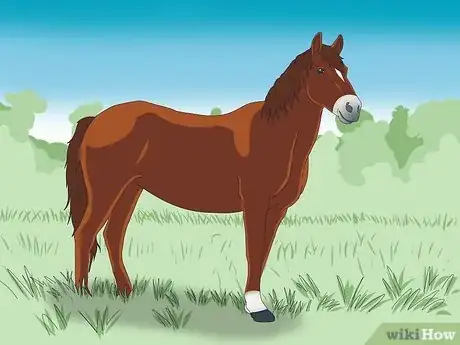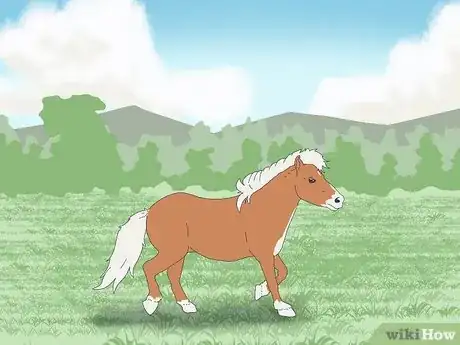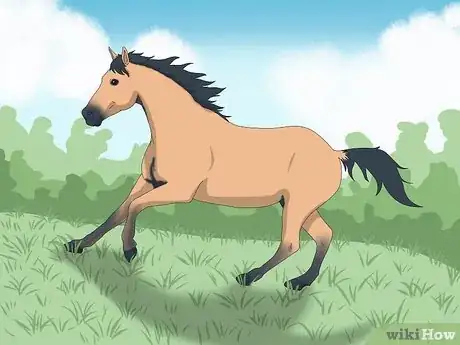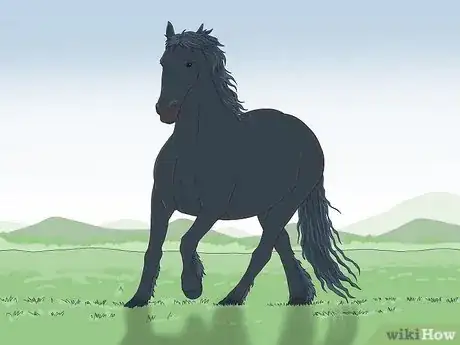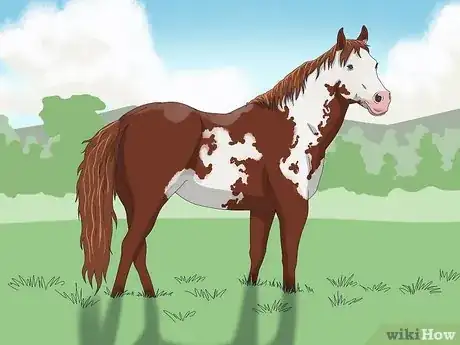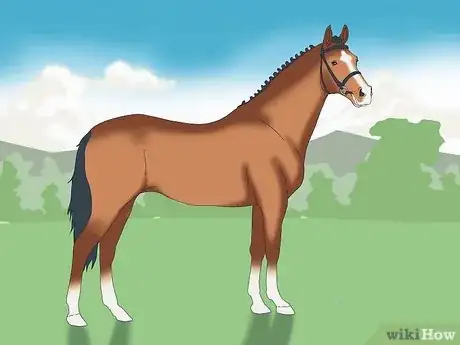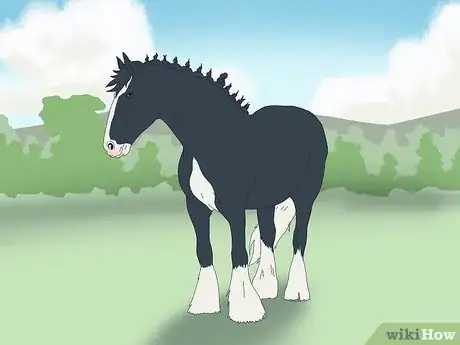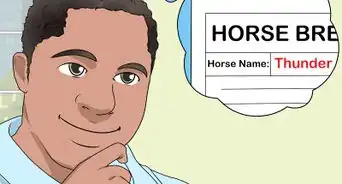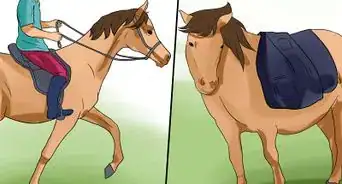This article was co-authored by Ryan Corrigan, LVT, VTS-EVN. Ryan Corrigan is a Licensed Veterinary Technician in California. She received her Bachelor of Science in Veterinary Technology from Purdue University in 2010. She is also a Member of the Academy of Equine Veterinary Nursing Technicians since 2011.
There are 10 references cited in this article, which can be found at the bottom of the page.
This article has been viewed 98,909 times.
Horses are wonderful creatures that can add a lot of fun and excitement to your life. However, narrowing down your choices to a specific breed can be incredibly difficult. Thankfully, you can make the process far easier by understanding each breed’s strengths and weaknesses.
Steps
Picking by Experience and Lifestyle
-
1Choose a calm, intelligent breed if you’re a beginner. If you’re just starting out, you’ll want a type of horse that is friendly and relaxed. The breed you pick should be fairly intelligent, meaning it can learn commands easily, and patient, meaning it won’t get frustrated if you make mistakes. In addition, you may want a breed of horse that has a fairly smooth gait, making it easier to ride.[1]
- No matter which breed you pick, get a horse that is at least 5 years old and has at least 1 year of professional training.
- Some good beginner breeds include the American Quarter Horse, Tennessee Walking Horse, Kentucky Mountain Horse, Shire Horse, Morgan, and Cleveland Bay.
-
2Get a pony if you’re young or short. If you’re under the age of 13 or less than 5.5 ft (170 cm) tall, you may have trouble mounting and controlling an adult horse. If this is the case for you, consider getting a pony instead. Ponies are just as fun as regular horses, but they’re small enough to accommodate petite riders.[2]
- Great pony breeds include the Pony of the Americas, Welsh Pony and Cob, and Shetland Pony.
- Keep in mind, though, that ponies can be stubborn and full of personality. Make sure to spend some time meeting different ponies and find one with a personality that matches yours.
Advertisement -
3Pick a balanced breed for trail riding. If you plan on riding your horse through long or uneven trails, you’ll need an all-around breed that has a firm build as well as decent endurance, speed, and strength. In addition, your horse’s body should be fairly proportional, that way it can keep its balance while moving.[3]
- Seek out trail breeds like the American Quarter Horse, Morgan, Missouri Fox Trotter, Rocky Mountain Horse, and Kentucky Mountain Horse.
-
4Get a draft horse for farm work and general labor. Draft horses are large, cold-blooded steeds specifically bred to plow fields, haul carts, and perform other types of hard labor. If you need a working steed, draft horses are your best bet.[4]
- Popular draft breeds include the Clydesdale, Shire Horse, Percheron, and Belgian Draft.
Choosing by Temperament
-
1Pick a cold-blooded breed if you want a calm animal. Cold-blooded horses are not actually cold-blooded. The term actually refers to even-tempered, not-very-excitable breeds. These are the gentle giants of the equine world. Horses from this breed are extremely low energy, making them friendly and approachable but also quite lazy.[5]
- Cold-blooded steeds are large, with many standing over 66 in (170 cm) tall, and heavy, often weighing more than 1,500 lb (680,000 g).
- Look for great cold-blooded breeds like the Clydesdale, Coldblooded Trotter, Icelandic Horse, Rocky Mountain Horse, Shire Horse, and Percheron.
-
2Choose a warm-blooded breed if you want a versatile horse. Warm-blooded horses were created by breeding hot-blooded and cold-blooded horses together. These steeds are smaller than most cold-blooded horses, meaning they can perform more physical stunts, and kinder than most hot-blooded horses, making them easier to approach and train.[6]
- Popular warm-blooded breeds include the American Quarter Horse, Appaloosa, Friesian Horse, Mustang, Andalusian, Irish Draught, Cleveland Bay, and Tennessee Walking Horse.
-
3Get a hot-blooded breed if you want an energetic steed. Hot-blooded horses have a lot of energy and personality, making them perfect for people who want to ride fast or participate in high-intensity competitions. However, these horses are often incredibly difficult to control and are likely to throw, kick, or bite inexperienced riders. That is why they typically require experienced owners.[7]
- Hot-blooded horses are usually small and slender.
- Good hot-blooded breeds include the Arabian, Thoroughbred, Marwari, and Morgan.
-
4Remember that each individual horse has its own temperament. Like all animals, horses are unique creatures that vary wildly from 1 specimen to another. As such, you may occasionally come across steeds that have different temperaments than other members of their breed.[8]
- When selecting your horse, focus on its individual temperament, not the temperament you think it’s supposed to have.
- Before buying a horse, ask to meet and test ride it. This will help you figure out if it has the type of temperament you want.
Selecting by Riding Discipline
-
1Pick a traditional cowboy breed for Western riding. Western riding is a catch-all term that refers to ranching styles created or popularized by American cowboys. Though you can teach this riding style to just about any warm-blooded or hot-blooded horse, most people prefer to use breeds associated with wild west mythology.[9]
- Standard cowboy breeds work well for the majority of Western riding events, including reining, barrel racing, cutting, penning, and roping.
- Common cowboy breeds include the American Quarter Horse, American Paint Horse, Mustang, and Appaloosa.
-
2Get a versatile horse for general English riding. Most English riding events demand a mixture of elegance and physical ability. As such, you’ll want to pick a breed of horse that has good balance, poise, and control but doesn’t lack strength or agility.
- Great English riding horses include the Hanoverian, Morgan, Friesian, Andalusian, Lipizzaner, Dutch Warmblood, and Belgian Warmblood.
-
3Choose a saddle breed for pleasure riding. Pleasure riding is a slow, methodical riding style designed to show off a horse’s appearance and personality. Saddle horses and similar breeds have slender, well-defined bodies that make them perfect for this riding discipline.[10]
- Common English pleasure riding breeds include the American Saddlebred, National Show Horse, Tennessee Walking Horse, Morgan, and Arabian.
- For Western pleasure riding, stick with tried-and-true saddle breeds like the American Saddlebred or similarly elegant species like the American Quarter Horse and Paint Horse.
-
4Pick a smart, confident breed for dressage. Dressage is an incredibly demanding type of English riding similar to interpretive dance. This style requires an incredible amount of memorization and performance ability, so you’ll need to choose a breed that has a lot of confidence and a high capacity for learning.[11]
- Popular dressage breeds include the Andalusian, Danish Warmblood, Hanoverian, Lusitano, Oldenburg, and Westphalian.
-
5Get a fast breed for racing. If you want to participate in traditional horse races, you’ll need to pick a breed that can build up a lot of speed quickly and maintain that momentum for an extended period of time.
- The most common racing breeds are the American Quarter Horse, Thoroughbred, and Arabian.
- For barrel racing, you’ll need to get a breed used for Western riding.
-
6Pick a high-stamina breed for endurance riding. Endurance riding is a style of horsemanship where you travel anywhere from 25 to 100 miles (40 to 161 km) in a single day. For this type of riding, you’ll need a breed of horse that can go incredibly long distances without tiring out.[12]
- Popular endurance riding breeds include the Arabian, Criollo, and Marwari.
-
7Choose a sport horse for show jumping. Show jumping is a popular riding discipline in which horses leap over a variety of fences and other obstacles. Horses that participate in jumping events need to have a lot of strength to propel themselves into the air and a lot of control to manage their speed.[13]
- Great show jumping breeds include the Belgian Warmblood, Danish Warmblood, Hanoverian, Holsteiner, and Oldenburger.
-
8Choose a large, highly trainable breed for vaulting. Equestrian vaulting is a form of gymnastics where the acrobat performs their stunts on top of a horse. This discipline requires a lot of space and coordination, meaning you’ll need a breed that’s both large enough to support your various gymnastic actions and smart enough to learn full routines.[14]
- For vaulting, go with horse breeds like the Clydesdale, Belgian Draft, Percheron, and Shire Horse.
References
- ↑ http://www.horsebreedsinfo.com/The-Five-Best-Breeds-for-Beginners.html
- ↑ http://www.horsechannel.com/horse-community/horse-breeds-for-kids.aspx
- ↑ https://horseandrider.com/trail-riding/selecting-trail-horse-15129
- ↑ http://alabamahorsecouncil.org/wp/wp-content/uploads/2011/10/ANR-0899-Light-Horse-Breeds.pdf
- ↑ http://www.worldanimalfoundation.net/f/Horse.pdf
- ↑ http://www.worldanimalfoundation.net/f/Horse.pdf
- ↑ http://www.worldanimalfoundation.net/f/Horse.pdf
- ↑ http://www.aces.edu/pubs/docs/A/ANR-1420/ANR-1420.pdf
- ↑ http://www.equiworld.net/uk/sports/western/westernintroduction/index.htm
- ↑ http://alabamahorsecouncil.org/wp/wp-content/uploads/2011/10/ANR-0899-Light-Horse-Breeds.pdf
- ↑ http://www.horseandriderbooks.com/pdfs/Dressage%20MBS%20coupon%20Excerpt.pdf
- ↑ http://thehorseridingsite.com/horse-riding-styles
- ↑ http://alabamahorsecouncil.org/wp/wp-content/uploads/2011/10/ANR-0899-Light-Horse-Breeds.pdf
- ↑ https://www.americanvaulting.org/startclub/selectinghorse.php
About This Article
When choosing a horse breed, consider your experience level and lifestyle needs. If you’re a beginner, pick a breed that’s calm and easy to teach, like an American Quarter Horse. You should also take your physical size into account. If you’re young or very small, for example, you might do best with a pony. Additionally, think about what kind of work the horse will be doing. For trail riding, it’s best to pick a well-balanced breed like a Morgan or Rocky Mountain Horse. If your horse will be doing labor, opt for a draft horse, such as a Clydesdale. For more tips from our Veterinarian co-author, including how to choose your horse based on temperament or riding style, read on!
